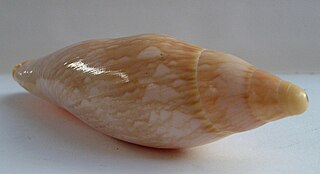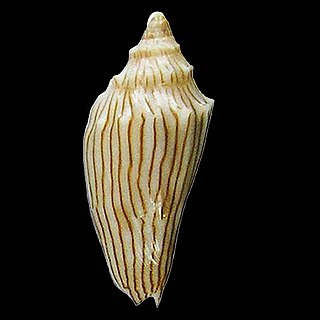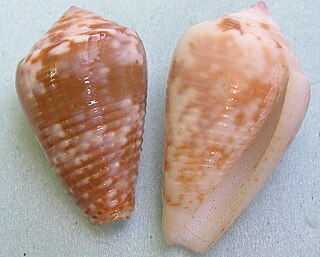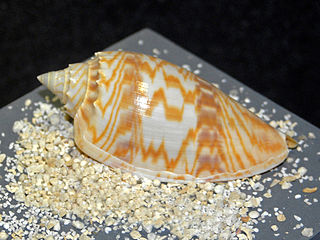
The crown-of-thorns starfish, Acanthaster planci, is a large starfish that preys upon hard, or stony, coral polyps (Scleractinia). The crown-of-thorns starfish receives its name from venomous thorn-like spines that cover its upper surface, resembling the biblical crown of thorns. It is one of the largest starfish in the world.

Conus marmoreus, common name the "marbled cone", is a species of predatory sea snail, a marine gastropod mollusk in the family Conidae, the cone snails, cone shells or cones. It is the type species for the genus Conus. This is a species which is believed to feed mostly on marine molluscs including other cone snails. This snail is venomous, like all cone snails.

The flamingo tongue snail is a species of small but brightly colored sea snail, a marine gastropod mollusk in the family Ovulidae, the ovulids, cowry allies or false cowries.

Melo miltonis, the southern bailer or southern baler, is a large sea snail, a marine gastropod mollusc in the family Volutidae, the volutes.

Cymbiolacca pulchra wisemani is a subspecies of large sea snail, a marine gastropod mollusc in the family volutidae, the volutes.

Conus geographus, popularly called the geography cone or the geographer cone, is a species of predatory cone snail. It lives in reefs of the tropical Indo-Pacific, and hunts small fish. While all cone snails hunt and kill prey using venom, the venom of conus geographus is potent enough to kill humans.

Amoria is a taxonomic genus of medium-sized predatory marine gastropod in the family Volutidae.

Lentigo lentiginosus, common name the silver conch, is a species of medium-sized sea snail, a marine gastropod mollusk in the family Strombidae, the true conchs.

Coral reef fish are fish which live amongst or in close relation to coral reefs. Coral reefs form complex ecosystems with tremendous biodiversity. Among the myriad inhabitants, the fish stand out as colourful and interesting to watch. Hundreds of species can exist in a small area of a healthy reef, many of them hidden or well camouflaged. Reef fish have developed many ingenious specialisations adapted to survival on the reefs.

Cassis cornuta, common name the horned helmet, is a species of extremely large sea snail, a marine gastropod mollusc in the family Cassidae, the helmet shells and their allies.

Ericusa is a small taxonomic genus of medium-sized predatory marine gastropod molluscs in the family Volutidae, the volutes.

Nannamoria is a small taxonomic genus of small-sized sea snails, predatory marine gastropod molluscs in the subfamily Amoriinae of the family Volutidae, the volutes.

Conus catus, common name the cat cone, is a species of sea snail, a marine gastropod mollusk in the family Conidae, the cone snails and their allies.

Amoria hunteri, common name Hunter's marbled volute, is a species of sea snail, a marine gastropod mollusk in the family Volutidae, the volutes.

Cymbiola aulica, also known as the princely or courtier volute is a species of sea snail, a marine gastropod mollusk in the family Volutidae, the volutes.

Cymbiola nobilis is a species of sea snail, a marine gastropod mollusk in the family Volutidae, the volutes. The snail's shell is commonly collected in the sea shell trade, which has resulted in overharvesting of the snail.

Livonia mammilla, common name false melon or false baler, is a species of sea snail, a marine gastropod mollusk of the genus Livonia in the family Volutidae, the volutes.

Acropora horrida is a species of acroporid coral that was first described by James Dwight Dana in 1846. Found in tropical, shallow reefs in marine environments, it occurs near fringing reefs around turbid water, at depths of 5 to 20 m. It is listed as a vulnerable species on the IUCN Red List, and it is thought to have a decreasing population. It is not common and found over a large area, and is listed under CITES Appendix II.
Acropora loisetteae is a species of acroporid coral that was first described by C. C. Wallace in 1994. Found in marine, tropical, shallow reefs in sheltered lagoons, it is found at depths between 1 and 30 m. It is listed as vulnerable on the IUCN Red List, and it is thought to have a decreasing population. It is not common but found over a large area, and is listed under CITES Appendix II.
Acropora multiacuta is a species of acroporid coral that was first described by F. Nemenzo in 1967. Found in marine, tropical shallow reefs in lagoons, on rocks or on the tops of reefs, it occurs at depths between 3 and 15 m. It is classed as a vulnerable species on the IUCN Red List, and it has a decreasing population. It is uncommon but found over a large area, including in two regions of Indonesia and the Great Barrier Reef, and is classified under CITES Appendix II.




















